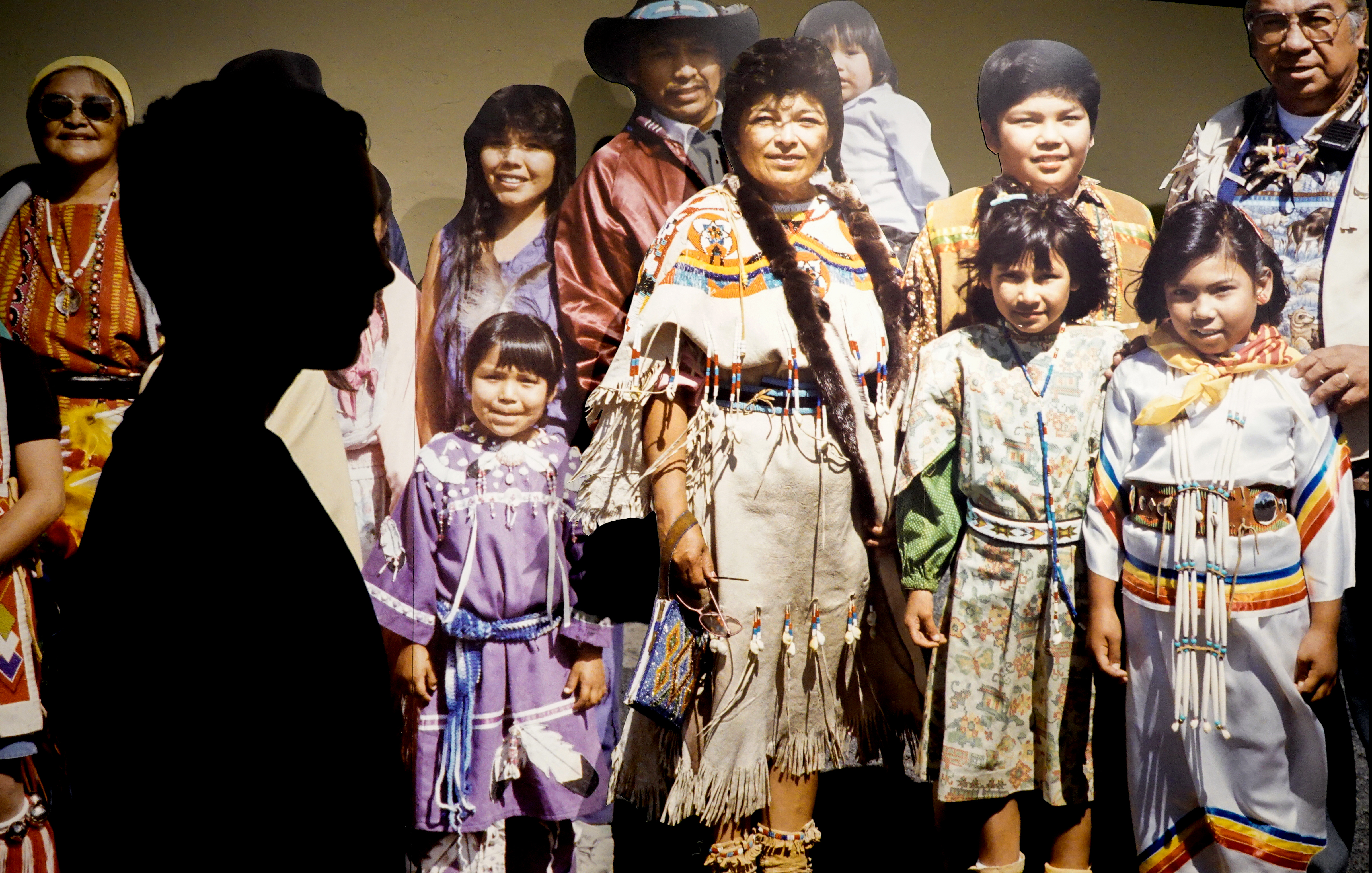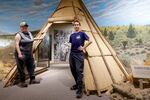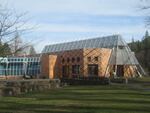
Mason Frye, left, explores the Museum at Warm Springs, March 18, 2023, passing by a display showing those who attended the museum's grand opening in March of 1993.
Emily Cureton Cook / OPB
Inside the Museum at Warm Springs on a recent day, 13-year-old Mason Frye gravitated toward things he recognized.
The young Warm Springs Tribal member paused to consider a grinding rock for herbs and spices. A display of baby boards sparked memories of his own baby board back at home. In front of another display case, he admired intricate baskets filled with familiar foods.
“This is luksh,” Mason said, using an Ichishkiin word. “It’s a native root that grows around here. There’s actually some behind our house. We pick it every year.”
Mason’s mom Jenaea Frye, who is Wasco, taught him how to dig edible roots like luksh — where to spot them, when to harvest, and most importantly, Mason said, how to plant the seeds back where you found them.
“He’s been digging luksh since he was like, 7 years old,” Jenaea said.
She’s a painter whose work is often inspired by the iconography inside this history and art museum on the Warm Springs Reservation in Central Oregon. Jenaea looks forward to entering her paintings in the museum’s annual Tribal Member Art Show. This year, she had so many pieces accepted they took up an entire wall.
“I just feel really inspired to keep going now,” she said. “It’s like, oh my gosh, am I an artist now? Have I arrived?”
For her Warm Springs family and many others, the museum is a point of pride.

Jenaea Frye, a painter who is inspired by imagery in the Museum at Warm Springs, stands with her son Mason, who is an aspiring sculptor. March 18, 2023.
Emily Cureton Cook / OPB
In 1988, Warm Springs tribal members voted to allocate $2.5 million, which at the time was the most money a tribe had committed, toward building its own museum. A year later, Congress passed legislation aimed at changing how an elite cultural institution related to tribes, by requiring the return of human remains and funerary items held by the Smithsonian, and by calling for the creation of the National Museum of the American Indian.
The Warm Springs museum opened first — 30 years ago this spring — when it became a national model for tribally-led cultural preservation across the country.
“There was a recognition that our family heirlooms and different things were being sold out of the reservation, and the antiquities market of American Indian art was a multibillion-dollar industry,” said the Museum’s executive director, Elizabeth Woody, who is Navajo, Warm Springs, Wasco and Yakama.
Over the decades, Warm Springs’ collection of artifacts has grown to include contemporary art and beadwork. Woody said all these exhibits are connected to the surrounding ecosystem, with its flowing creek and cottonwood groves.
“The land is populated by otters, birds, kestrels, eagles. We have all kinds of amphibians and reptiles. There’s just a lot people can come here and experience,” Woody said.
Water and birds babble in the background of an archival recording of the museum’s 1993 opening ceremony. Then-Warm Springs Tribal Council Chairman Raymond Tsumpti Sr. welcomed the crowd by describing how separate tribes — the Wasco and Warm Springs — signed a treaty with the U.S. government in 1855, before moving onto a tiny fraction of their home lands. Then, the U.S. military forced a third tribe, the Paiute, to move hundreds of miles and live on the same reservation.

The Museum at Warm Springs is Oregon's first tribal museum, honoring the culture and history of the Confederated Tribes of Warm Springs. The museum is celebrating its 30th anniversary this year with public events, programs and exhibits.
Courtesy The Museum at Warm Springs
“By 1879, our reservation featured three tribes, with three different languages, different customs, traditions and lifestyles... But we learned to get along with each other… We learned that our diversity could be an asset,” Tsumpti Sr., who is Warm Springs and Wasco, said in 1993.
At the museum today, that diversity is heard in recordings of elder storytellers and tribal members narrating the exhibits. Their voices show an important paradigm shift, said Rick West, who was the founding director of the Smithsonian’s National Museum of the American Indian.
“Native people had always been interpreted in the third person. Nobody ever asked us what we knew about our own selves and our own material,” said West, who is a citizen of the Cheyenne and Arapaho tribes in Oklahoma and a peace chief of the Southern Cheyenne.
Before the Smithsonian would open a space dedicated to Native American cultures on the national mall in Washington, D.C., or dozens of other tribes would launch their own museums and cultural centers, Warm Springs paved the way.
“Warm Springs was sort of the first on the block in that regard, and it was very important to us,” West said. “Cultural continuance and preservation was not going to be centered in New York City and Washington D.C. Culture is preserved in community.”

Volunteers help clean up the grounds at the Museum at Warm Springs on March 18, 2023.
Emily Cureton Cook / OPB
Sunmiet Maben, the operations manager for the Museum at Warm Springs, hopes this year’s 30th birthday milestone can be a turning point for the practical side of preservation, such as installing a new HVAC system, and work to repair and refresh the exhibits.
“At the moment it’s a struggle because we are an aging building,” she said.
After years of pandemic-related closures and staff shortages, staying open is a financial challenge.
“We fall into that category with a lot of museums where you just want to bring in enough money to keep the doors open and keep the mission going,” Maben said.
The museum draws about 12,000 visitors annually. Maben, who is Wasco, Warm Springs and Lummi, wants them to leave with a sense of how the cultures depicted inside the museum aren’t of the past.
“We are still living, breathing, existing people,” she said.



